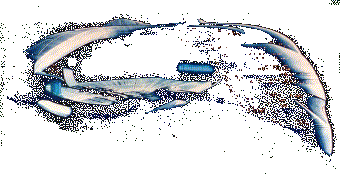   
| |

Cloaking Device
On Stardate 1709.1 the Bonhomme Ri Romulan Space. Suddenly, it vanished from
the sensors, reappeared directly in front of the outpost and fired what later
came to be called a "plasma torpedo". The torpedo obliterated the
outpost's deflector screens, nearly destroying it. A second shot finished the job. Then the ship simply disappeared from view.
 |
That was the first encounter with the Romulans after almost a century since the
battle of Cheron. The vessel that destroyed S-4023 (and also S-4024 and S-4025)
was a Romulan P-1A Bird
of Prey with a first generation cloaking device. Later, a third generation cloaking device has been obtained by the U.S.S.
Enterprise in an espionage mission. |
The Klingons gained the technology from their alliance with the Romulans in
exchange for their D-6 Raxor and D-7
Klolode battle cruisers. Thus the three major powers in this part of the
galaxy came to posses what proved to be one of the most formidable weapons ever.
Star Fleet, which used the cloaking device on its vessels in the late 2200's and
early 2300's, has decided that the peaceful (mostly) mission definition of the
Explorer type of starships precludes its use. Further- more, the overall shape
and hull materials used in the Galaxy, Ambassador, and Oberth class starships
would interfere with the cloaking device. Although it is still possible to cloak
them, the energy necessary increases beyond reasonable limit. Today, only
specialized scouting, stealth, and battle ships use cloaking devices.
The Klingon Empire has used the cloaking technology ever since their technology
exchange with the Romulans in 2263, and continues to do so. Nearly all of its
Bird of Prey type ships are equipped with it as are the D- 6, D-7, D-8 (K'T'Inga),
and the new K'Vort class battle cruisers.
| It is
certain that the newest vessels, the D'Deridex
class warbirds, are equipped with a new generation of cloaking devices which
have so far defied all Federation attempts at detection without the use of
tachyons. |
 |
Our cloaking device is an energy screen generator used to render a ship or
object invisible to the eye and to most sensor systems. This is accomplished by
gravitational lensing, the creation of a distorted image of an object when it's
light is focused by gravity. In the case of a cloaking device, the light is
focused so that the object's index of refraction (the phase velocity of
radiation in free space divided by the phase velocity of the same radiation in a
specified medium) matches its surroundings, making the object transparent.
Cloaking a ship requires precisely balancing the radiative emissions from the
warp drive nacelles, dissipating all electromagnetic radiation, gravitational
fields and other energy emissions emanating from the ship, and distorting space
in such a way that electromagnetic radiation and energy emissions are directed
around the ship through subspace at velocities faster than light.
Cloaking devices have been classified into the following categories according
to their overall effectiveness:
Mk 1 Cloak: Original usage, early Warbirds only. Used electromagnetic radiation
shielding quite effectively to cloak only visible and near-visible radiation.
Can instantaneously cloak and decloak, but required large amounts of power.
Mk 2 Cloak: A major improvement on the Mk 1, this device cloaked all
electromagnetic radiation, except high energy Gamma rays. Can instantaneously
cloak and decloak, but was remarkably inefficient. Craft: Romulan Scouts and
Warbirds, also Klingon D-7 Cruisers, and later the joint Romulan/Klingon scout
and Bird Of Prey.
Mk 3.0 Cloak: The first gravity distorting cloak. The early prototype craft had
problems with energetic effects occurring inside the cloak as a result of
trapped spurious thermal emissions within the cloaking field. This was overcome
by giving the craft a green coloration. This tuned the thermal energy to a
frequency where it could leak very slowly through the cloak without revealing
the ships presence, still common practice on most cloaked vessels. This early Mk
3 had only the spherical field setting and could not be effectively wavemapped.
It could not instantly cloak and decloak, but saw much use on most Romulan craft
and the Bird Of Prey.
Mk 3.1 Cloak: This improved device featured instantaneous propagation of the
spherical cloak, and first saw use of the wavemapped cloak. It is reported to
have been used as above and as an upgraded cloak for D-7 Cruisers. A green
coloration was still necessary.
Mk 3.2 Cloak: This version saw the creation of the fine tuned cloak, using the
special dedicated computers. This device was perhaps first created by the
Klingons, but required large power reserves. The Romulans later reworked the
idea into a more efficient form (officially designated the Mark 3.2a). The old
cloak is still in active service on older Klingon craft.
Mk 3.2a Cloak: Romulan reworking of the 3.2. No special coloration of the craft
is necessary, although the nullifier cores require less energy when the ship has
a green color. The cloak is still extensively used by Romulans and Klingons
alike.
Mk 3.3 Cloak: This latest version allowed powering down of all non-finely tuned
cloaks instantly. It is only fitted, as far as is known, to Romulan Warbirds.
Klingons claim to still use the 3.2a.
Experimental Mk 4 Cloak: There is an experimental cloaking device which utilizes
a highly-wavemapped, adaptive, asymmetrical dispersion pattern. This cloaking
device's cloaking generator coils are equipped with field actuators that change
the dispersion pattern, to be most efficient in any interstellar condition,
considering many variables, such as gas density, electric and magnetic fields,
and fluctuations in the subspace domain. These field actuators compensate for
any of these variables or active scans if the vicinity of the cloaked ship is
being probed. There is no danger of a spatial ripple occurring. This would
render a ship undetectable, except with a tachyon heterodyne detection grids,
which, if powerful enough, could detect a ship that was cloaked in this manner.

  
|


![]()




